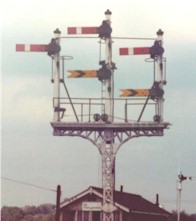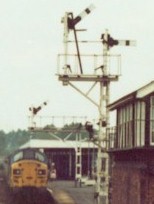 |
Network Rail |

The left arm was to the Down goods line, the centre arm was to the Down Main, and the right arm was to a bi-directional line to Ely Station South signal box, the exact name I am unsure of. The distant signals were operated from Ely Station South signal box until it closed on 29th June 1985 from when they were operated by Ely Station North signal box. The arm to the left indicates a diverging route to the down platform, that to the right indicates the route to the up (southbound) branch platform (used in both directions)
The distant signals under the main and right hand arms are for Ely North box, which is at the opposite end to the station. Behind the signal you can see Ely Dock Junction box.
The white hexagon plate tells the driver that the track occupancy is displayed in the signal box, so he doesn't have to report immediately to the signalman in case of halting in front of a signal at danger.
The yellow number "10" (note: see large picture) is a speed restriction, and the arrow indicated that it applies through the points that go to the right. Unfortunately the main line at Ely was electrified and resignalled in the 1980s, and now has colour light signals controlled mainly from Cambridge.

Just behind the departing train we can just see the roof of Ely North signal box and also the two signals which control departure from platform 1 (still clear for the departing train) and the down main line. These are controlled by the North box To the right of the picture we can see a southbound Kings Lynn - London service, which is standing in platform 2, the up main line. Hidden by Ely South signal box is platform 3, which is normally used by trains taking the branch line to Ipswich.
To the right of the box are (left to right): No.3 platform line, two sidings, and the goods avoiding line (allows freight trains to bypass the station). Ely South box controls all of the signals at the South end of the station.
Note the typically Victorian over provision of signals on the up line - one to control departure from the platform, immediately followed by one that control the divergence of the Ipswich branch.
Just above the cab of our locomotive you can see part of the signal gantry at which we are stopped. The small arm with the red and white stripes is a subsidiary signal, which allows a train to pass the main signal at danger in certain specially defined circumstances and proceed along the down main. If cleared, the little signal would show an illuminated letter "C" (black on white).
There are three types of subsidiary signal, each of which shows a different letter:
"C" = "Calling on": the line ahead is occupied by another train,
proceed with caution, (Normally used for freight trains only, but can be used for
passenger trains in platforms)
"W" = "Warning": The line ahead is occupied immediately beyond the
next signal. (Normally the signaller needs to have a defined clear margin beyond the next
signal before he can clear the preceding signal).
"S" = "Shunt ahead": pass the main signal at danger to make a shunting
move. This is not an authority to proceed to the next signal. We will wait for the left
main arm (out of picture), which will allow us to proceed into the platform loop.
This photo was taken May 1982, and the scene here has changed considerably. The line has been electrified, the London trains are now worked by electric multiple units, and all of the semaphore signals have been replaced by colour lights, which are controlled from Cambridge. Platform 1 has been extended outwards over the platform loop line and now faces onto the down main line. The down freight sidings on the extreme left have now been taken out, and the site is occupied by a supermarket.
 home
home foreign signals index
foreign signals index email
email Dutch signals
Dutch signals Canadian signals
Canadian signals